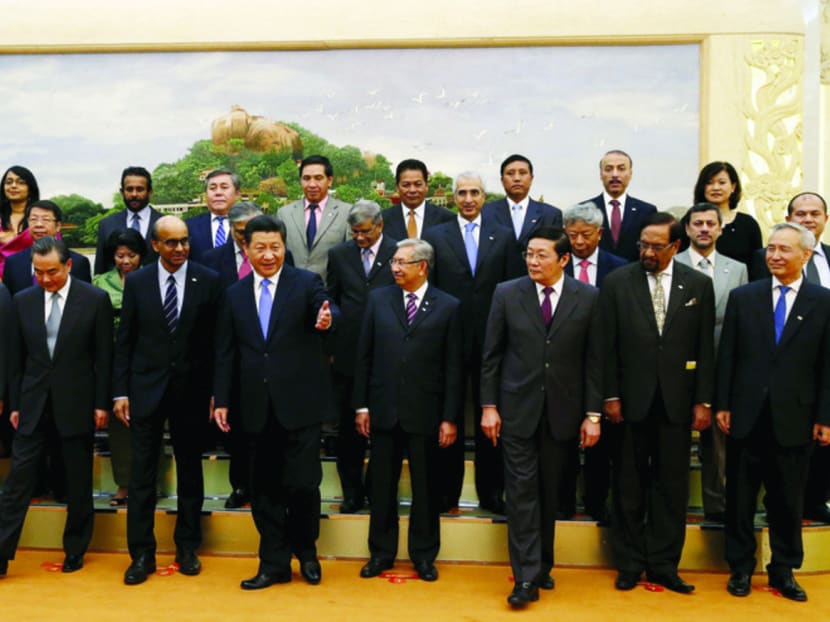Investors wait for clarity as China turns to infrastructure
Mr Zhou Yuan told a conference in Hong Kong last week that he could not promise to inform them, but that he hoped to entertain them. The dry-humoured head of strategy for China Investment Corporation (CIC) then proceeded to do both as he talked about how China would view infrastructure investment in the region.

Mr Xi (front row, centre) and other leaders, including Singapore’s Finance Minister Tharman Shanmugaratnam (front row, fourth from left), at the AIIB launch ceremony in Beijing last year. Photo: Reuters
Mr Zhou Yuan told a conference in Hong Kong last week that he could not promise to inform them, but that he hoped to entertain them. The dry-humoured head of strategy for China Investment Corporation (CIC) then proceeded to do both as he talked about how China would view infrastructure investment in the region.
Few subjects generate more interest and debate in Asian financial circles than infrastructure. Participants want to know how the new China-led Asian Infrastructure Investment Bank (AIIB) will operate and what roles other groups, such as banks and long-term investors, might play.
At the heart of the matter are enormous estimates of what Asia needs to spend on infrastructure in the coming years and questions about how much of this China will provide — and on what terms.
“If you can’t expect a return — that is, if you can’t expect infrastructure projects to pay you a dividend some time down the road, you can’t call that investment any more. You might as well call that a Marshall Plan,” Mr Zhou said at the FT Investment Management Summit.
Inevitably, comparisons abound between China’s AIIB and the United States-financed 1948 Marshall Plan that supported European rebuilding after the second world war, and that deployed its current account surpluses in a way that backed American economic and geopolitical goals.
COMMERCIAL FOCUS NEEDED
China’s current plans include its Silk Road economic initiative (One Belt, One Road), its interest in a BRICS development bank as well as the AIIB and other investments such as those funded by CIC, its sovereign wealth fund.
China Development Bank reckons the number of cross-border projects in train under the Silk Road effort already total US$980 billion (S$1.3 trillion) in investment value. Other figures put Asia’s total need nearer US$8 trillion by 2020.
“Everyone will give you a different number. The one thing is they will all be wrong but they will all be big,” said Mr James Cameron, head of project and export finance for HSBC in Asia.
Back on the ground, China’s planned spending has banks and other investors wondering what might be left for them. Project financiers are already struggling because regulators are forcing banks to hold more capital against long-term lending in riskier emerging markets.
Investors do not have it much easier. Backing a power station in Vietnam, secured against the future income of the plant, might seem a good bet to a pension fund manager looking for assets to match long-term liabilities. But regulators are worried about the currency and the country risk, so they ask for capital and other regulatory protections, pushing up the cost of such investments.
“Pension funds and insurance companies are very interested but may not always be able to invest,” said Mr Francois Leblanc, head of BNP Paribas’ Asia-Pacific financial institutions team, who cited funds’ own investment guidelines as another constraint. “There are a lot of difficulties. Bridging the gaps isn’t easy between what markets can deliver today and what investors need,” he said.
On that basis, Mr Zhou’s comments about a commercial focus, at least from CIC, will be welcomed. One fear has been that China would persist with vendor-style financing, where many developing countries with natural resources received funding for infrastructure — supplied, financed and built by Chinese firms.
If China is more serious about a commercially based markets-based system — including via the AIIB, which it will lead — then Asia more generally stands to gain.
“The AIIB has a range of potential tools,” said Mr Cameron. “They could invest or fund directly, look at perhaps taking a slice of the risk, provide guarantees or help with ensuring the right advice is given up front to structure projects to be more attractive for outside financing and investment. There is a lot that could help develop the whole infrastructure financing space.”
Asian infrastructure is particularly tricky because of the region’s different legal systems and markets, all at varying stages of development. The sheer range of projects under way complicates the sector further.
But any sign of standardisation — such as one power station or road system using the same funding template used by a previous, successful venture — would help the next project. And that could ultimately transform Asian financing as well as its infrastructure landscape. THE FINANCIAL TIMES
About the author:
Based in Hong Kong, Jennifer Hughes is the Asia Financial Correspondent for The Financial Times.






